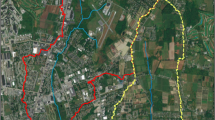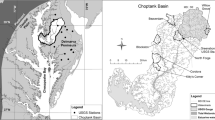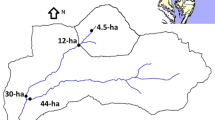Abstract
Fluxes of dissolved and particulate nitrogen (N) and phosphorus(P) from three adjacent watersheds were quantified with ahigh-resolution sampling program over a five-year period. The watershedsvary by an order of magnitude in area (12,875, 7968 and 1206 ha), and inall three watersheds intensive agriculture comprises > 90% ofland. Annual fluxes of dissolved N and P per unit watershed area (exportcoefficients) varied ∼2X among watersheds, and patterns were notdirectly related to watershed size. Over the five-year period, meanannual flux of soluble reactive P (SRP) was 0.583 kg P ·ha−1 · yr−1 from the smallestwatershed and 0.295 kg P · ha−1 ·yr−1 from the intermediate-sized watershed, which hadthe lowest SRP flux. Mean annual flux of nitrate was 20.53 kg N ·ha−1 · yr−1 in the smallestwatershed and 44.77 kg N · ha−1 ·yr−1 in the intermediate-sized watershed, which had thehighest nitrate flux. As a consequence, the export ratio of dissolvedinorganic N to SRP varied from 80 (molar) in the smallest watershed to335 in the intermediate-sized watershed. Because most N was exported asnitrate, differences among watersheds in total N flux were similar tothose for nitrate. Hence, the total N:P export ratio was 42(molar) for the smallest watershed and 109 for the intermediate-sizedwatershed. In contrast, there were no clear differences among watershedsin the export coefficients of particulate N, P, or carbon, even though> 50% of total P was exported as particulate P in allwatersheds. All nutrient fractions were exported at higher rates in wetyears than in dry years, but precipitation-driven variability in exportcoefficients was greater for particulate fractions than for dissolvedfractions.
Examination of hydrological regimes showed that, for all nutrientfractions, most export occurred during stormflow. However, theproportion of nitrate flux exported as baseflow was much greater thanthe proportion of SRP flux exported as baseflow, for all threewatersheds (25–37% of nitrate exported as baseflow vs.3–13% of SRP exported as baseflow). In addition, baseflowcomprised a greater proportion of total discharge in theintermediate-sized watershed (43.7% of total discharge) than theother two watersheds (29.3 and 30.1%). Thus, higher nitrateexport coefficients in the intermediate-sized watershed may haveresulted from the greater contribution of baseflow in this watershed.Other factors potentially contributing to higher nitrate exportcoefficients in this watershed may be a thicker layer of loess soils anda lower proportion of riparian forest than the other watersheds. Theamong-watershed variability in SRP concentrations and exportcoefficients remains largely unexplained, and might represent theminimum expected variation among similar agriculturalwatersheds.
Similar content being viewed by others
References
Allan JD, Erickson DL & Fay J (1997) The influence of catchment land use on stream integrity across multiple spatial scales. Freshwater Biol. 37: 149-161
Baker DB (1993) The Lake Erie Agroecosystem Program: Water quality assessments. Agricult. Ecosyst. Environ. 46: 197-215
Beaulac MN & Reckhow KH (1982) An examination of land use-nutrient export relationships. Water Resources Bull. 18: 1013-1024
Boggess CF, Flaig EG & Fluck RC (1995) Phosphorus budget-basin relationships for Lake Okeechobee tributary basins. Ecol. Eng. 5: 143-162
Brenner FJ & Mondok JJ (1995) Nonpoint source pollution potential in an agricultural watershed in northwestern Pennsylvania. Water Resources Bulletin 31: 1101-1112
Caraco NF & JJ Cole (1999) Human impact on nitrate export: An analysis using major world rivers. Ambio 28: 167-170
Carpenter SR, Caraco NF, Correll DL, Howarth RW, Sharpley AN & Smith VH (1998) Nonpoint pollution of surface waters with phosphorus and nitrogen. Ecol. Appl. 8: 559-568
Cleresci NL, Curran SJ & Sedlak RI (1986) Nutrient loads toWisconsin lakes: Part 1. Nitrogen and phosphorus export coefficients. Water Resources Bull. 22: 983-990
Cohn TA (1995) Recent advances in statistical methods for the estimation of sediment and nutrient transport in rivers. Rev. Geophys. 33 (Suppl): 1117-1123
Cohn TA, DeLong EE, Gilroy EJ, Hirsch RM & Wells DK (1989) Estimating constituent loads. Water Resources Res. 25: 937-945
Cooke SE & Prepas EE (1998) Stream phosphorus and nitrogen export from agricultural and forested watersheds on the Boreal Plain. Can. J. Fish. Aquat. Sci. 55: 2292-2299
Correll DL (1998) The role of phosphorus in the eutrophication of receiving waters: A review. J. Environ. Qual. 27: 261-267
Correll DL, Jordan TE & Weller DE (1999) Effects of precipitation and air temperature on phosphorus fluxes from Rhode River watersheds. J. Environ. Qual. 28: 144-154
Creed IF & Band LE (1998) Export of nitrogen from catchments within a temperate forest: Evidence for a unifying mechanism regulated by variable source area dynamics. Water Resources Res. 34: 3105-3120
Crumpton WG, Isenhart TM & Mitchell PD (1992) Nitrate and organic N analyses with second derivative spectroscopy. Limnol. Oceanogr. 37: 907-913
Daniel TC, Sharpley AN & Lemunyon JL (1998) Agricultural phosphorus and eutrophication: A symposium overview. J. Environ. Qual. 27: 251-257
DeVantier BA & Feldman AD (1993) Review of GIS applications in hydrologic modeling. J. Water Resources Planning and Management. 119: 246-261
Dillon PJ & Kirchner WB (1975) The effects of geology and land use on the export of phosphorus from watersheds. Water Research 9: 135-148
Downing JA, McClain M, Twilley R, Melack JM, Elser J, Rabalais NN, Lewis Jr. WM, Turner RE, Corredor J, Soto D, Yanez-Arancibia A, Kopaska JA & Howarth RW (1999) The impact of accelerating land-use change on the N-cycle of tropical aquatic ecosystems: Current conditions and projected changes. Biogeochemistry 46: 109-148
Gambrell RP, Gilliam JW & Weed SB (1975) Nitrogen losses from soils of the North Carolina Coastal Plain. J. Environ. Qual. 4: 317-322
Gburek WJ & Sharpley AN (1998) Hydrologic controls on phosphorus loss from upland agricultural watersheds. J. Environ. Qual. 27: 267-277
Grayson RB, Moore ID & McMahon TA (1992) Physically based hydrologic modeling 2. Is the concept realistic? Water Resources Res. 26: 2659-2666
Groffman PM, Simmons RC & Gold AJ (1992) Nitrate dynamics in riparian forests: Microbial studies. J. Environ. Qual. 21: 666-671
Gustard A, Bullock A & Dixon JM (1992) Low flow estimation in the United Kingdom. Report 108 (pp 19-25). Institute of Hydrology, Wallingford, England
Heckrath G, Brookes PC, Poulton PR & Goulding KWT (1995) Phosphorus leaching from soils containing different phosphorus concentrations in the Broadbalk experiment. J. Environ. Qual. 24: 904-910
Hessen DO, Hindar A & Holtan G (1997) The significance of nitrogen runoff for eutrophication of freshwater and marine recipients. Ambio 26: 312-320
Hill AR (1996) Nitrate removal in stream riparian zones. J. Environ. Qual. 25: 743-755
Howarth RW (1988) Nutrient limitation of net primary production in marine ecosystems. Ann. Rev. Ecol. Syst. 19: 89-110
Howarth RW, Billen G, Swaney D, Townsend A, Jaworski N, Lajtha K, Downing JA, Elmgren R, Caraco N, Jordan T, Berendse F, Freney J, Kudeyarov V, Murdoch P & Zhu ZL (1996) Regional nitrogen budgets and riverine N& P fluxes for the drainages to the North Atlantic Ocean: natural and human influences. Biogeochemistry 35: 75-139
Hunsaker CT & DA Levine DA (1995) Hierarchical approaches to the study of water quality in rivers. BioScience 45: 193-203
Jansson M (1985) A comparison of detransformed logarithmic regressions and power function regressions. Geografiska Annaler 67A: 61-70
Jordan TE, Correll DL & Weller DE (1993) Nutrient interception by a riparian forest receiving inputs from adjacent cropland. J. Environ. Qual. 22: 467-473
Jordan TE, Correll DL & Weller DE (1997a) Relating nutrient discharges from watersheds to land use and streamflow variability. Water Resources Res. 33: 2579-2590
Jordan TE, Correll DL & Weller DE (1997b) Nonpoint source discharges of nutrients from piedmont watersheds of Chesapeake Bay. J. Amer. Water Resources Assoc. 33: 631-645
Kalkhoff SJ (1995) Relation between stream-water quality and geohydrology during base-flow conditions, Roberts Creek watershed, Clayton County, Iowa. Water Resources Res. 31: 593-604
Kennedy EJ (1983) Computation of continuous records of streamflow. Techniques of Water-Resources Investigations of the United States Geological Survey, Book 3. U.S. Geological Survey
Lewis WM Jr, Melack JM, McDowell WH, McClain M & Richey JE. 1999. Nitrogen yields from undisturbed watersheds in the Americas. Biogeochemistry 46: 149-162
Likens GE & FH Bormann (1995) Biogeochemistry of a forested ecosystem. Second edition. Springer-Verlag
Logan TJ (1990) Sustainable agriculture and water quality. In: Edwards CA, Lal R, Madden P, Miller RH & House G (Eds) Sustainable Agricultural Systems (pp 582-613). Soil and Water Conservation Society, Ankeny, Iowa, USA.
Medley KE, Okey BW, Barrett GW, Lucas MF & Renwick WH (1995) Landscape change with agricultural intensification in a rural watershed, southwestern Ohio, USA. Landscape Ecol 10: 161-176
Miltner RJ & Rankin ET (1998) Primary nutrients and the biotic integrity of rivers and streams. Freshwater Biol. 40: 145-158
Mueller DK, Hamilton PA, Helsel DR, Hitt KJ & Ruddy BC (1995) Nutrients in ground water and surface water of the United States-An analysis of data through 1992. United States Geological Survey Water-Resources Investigations Report 95-4031
Murphy J & Riley JP (1962) A modified single solution method for the determination of phosphate in natural waters. Anal. Chim. Acta. 27: 31-36
Naiman RJ, Ed (1992) Watershed management: Balancing Sustainability and Environmental Change. Springer, New York
Naiman RJ, Magnuson JJ, McKnight DM & Stanford JA, Eds (1995) The Freshwater Imperative: A Research Agenda. Island Press, Washington DC.
Nathan RJ & McMahon TA (1990) Evaluation of automated techniques for base flow and recession analyses. Water Resources Research 26: 1465-1473
Omernik JM (1976) The influence of land use on stream nutrient levels. United States Environmental Protection Agency Report EPA 600/3-76-014, Corvallis, Oregon
Osborne LL & Kovacic DA (1993) Riparian vegetated buffer strips in water quality restoration and stream management. Freshwater Biol. 29: 243-258
Porterfield G (1972) Computation of fluvial-sediment discharge. Techniques of Water-Resources Investigations of the United States Geological Survey, Book 3. U.S. Geological Survey
Prairie YT & Kalff J (1986) Effect of catchment size on phosphorus export. Water Resources Bull. 22: 465-470
Puckett LJ (1995) Identifying the major sources of nutrient water pollution. Environ. Sci. Tech. 29: 408-414
Richards RP & Baker DB (1993) Trends in nutrient and suspended sediment concentrations in Lake Erie tributaries, 1975-1990. J. Great Lakes Res. 19: 200-211
Richards RP & Holloway J (1987) Monte Carlo studies of sampling strategies for estimating tributary loads. Water Resources Res. 23: 1939-1948
Schaus MH, Vanni MJ, Wissing TE, Bremigan MT, Garvey JA & Stein RA (1997) Nitrogen and phosphorus excretion by detritivorous fish (the gizzard shad, Dorosoma cepedianum) in a reservoir ecosystem. Limnol. Oceanogr. 42: 1386-1397
Sharpley AN (1995) Identifying sites vulnerable to phosphorus loss in agricultural runoff. J. Environ. Qual. 24: 947-951
Sims JT, Simard RR & Joern BC (1998) Phosphorus loss in agricultrual drainage: Historical perspective and current research. J. Environ. Qual. 27: 277-293
Smith RA, Alexander RB & Wolman MG (1987) Water-quality trends in the nation's rivers. Science 235: 1607-1615
Smith VH (1998) Cultural eutrophication of inland, estuarine, and coastal waters. In: Pace ML & Groffman PM (Eds) Successes, Limitations, and Frontiers in Ecosystem Science (pp 7-49). Springer, New York
Sokal RR & Rohlf FJ (1981) Biometry. Second edition. Freeman, New York
Solorzano L (1969) Determination of ammonia in natural waters by the phenolhypochlorite method. Limnol. Oceanogr. 14: 799-801
Soranno PA, Hubler SL, Carpenter SR & Lathrop RC (1996) Phosphorus loads to surface waters: A simple model to account for spatial pattern of land use. Ecol. Appl. 6: 865-878
Stainton MP, Capel MJ & Armstrong FAJ (1977) The chemical analysis of fresh-water. Miscellaneous Special Publication 25. Freshwater Institute, Winnipeg
Steinheimer TR, Scoggin KD & Kramer LA (1998) Agricultural chemical movement through a field-size watershed in Iowa: Surface hydrology and nitrate loss in discharge. Environ. Sci. Tech. 32: 1048-1052
USDA (United States Department of Agriculture) (1992) Watershed plan and environmental assessment for Four Mile Creek Watershed, Ohio and Indiana
Vitousek PM, Gosz JR, Grier CC, Melillo JM, Reiners WA & Todd RL (1979) Nitrate loss from disturbed ecosystems. Science 204: 469-474
Winner RW, Strecker RL & Ingersoll EM (1962) Some physical and chemical characteristics of Acton Lake, Ohio. Ohio J. Sci. 62: 55-61
Author information
Authors and Affiliations
Corresponding author
Rights and permissions
About this article
Cite this article
Vanni, M.J., Renwick, W.H., Headworth, J.L. et al. Dissolved and particulate nutrient flux from three adjacent agricultural watersheds: A five-year study. Biogeochemistry 54, 85–114 (2001). https://doi.org/10.1023/A:1010681229460
Issue Date:
DOI: https://doi.org/10.1023/A:1010681229460




